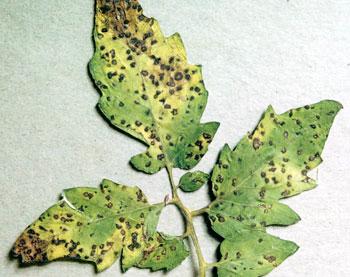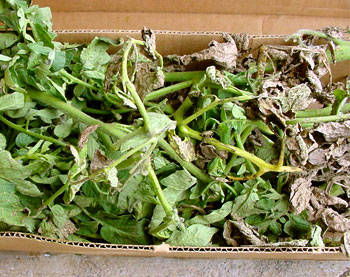Septoria leaf spot on tomatoes: More ways to prevent spots before your eyes
Tomato gardeners should learn the symptoms of Septoria leaf spot and try these tips for stopping its spread.
Editor's note: Tomatoes are susceptible to several diseases in the summer. To help you identify whether your tomatoes are infected with Septoria leaf spot or another disease, see the tip sheet "Tomato Diseases in the Home Garden."
Tomatoes are one of the favorite fruits or vegetables gardeners grow every year. They are unique in several respects. Botanically, the tomato is a fruit. It is classified as such because the portion that is eaten contains reproductive structures (seeds). However, in 1893, the tomato was declared a vegetable by the United States Supreme Court. The reason involved the collection of import duties. So, the tomato is either a fruit or a vegetable, depending on whose definition is used.
The tomato was called the “love apple “and believed to be poisonous until around 1850. It was only grown for its attractive but forbidden fruits. Because it is in the same family as nightshade, it was considered unsafe for human consumption.
Regardless of its interesting history, almost all gardeners include a tomato or two for their eating pleasure. Michigan summers with their warm and often humid climate are favorable for various leaf blights to develop. One of the common tomato maladies is Septoria leaf spot. It is a fungal disease that affects the leaves, but not the fruit. The first leaves that are affected are typically toward the bottom of the plant. The leaves develop small, dark spots that rapidly enlarge to 0.25 inches and have a tan or gray center. There may be small, black dots, which are the fruiting bodies of the fungus, located in the center of the spot. If there are enough spots, the leaves turn yellow, then brown. The leaf eventually wilts, dries up and falls off. The Septoria pathogen will then spread via water splashing to the upper leaves causing defoliation further defoliation. Michigan State University Extension hotlines are just beginning to answer questions about Septoria now.


Left, Signs of Septoria leaf spot on a tomato leaf. Photo credit: William M. Brown Jr., Bugwood.org.
Right, Leaf spotting and advanced decay of Septoria leaf spot. Photo credit: Paul Bachi, Univ. of Kentucky Research and Education Center, Bugwood.org
Septoria can be prevented but not cured once it is evident. If Septoria has been a problem on tomatoes in previous years, it may become an issue in subsequent years especially if the tomatoes are always planted in the same garden spot each year. The pathogen survives best on tomato foliage but may also infect Solanceous weeds related to tomatoes like Jimson weed, horse nettle, ground cherry and nightshade. When conditions are wet, spores are exuded from the Septoria fruiting bodies present on the infected tomato leaves. Once the spores land on a healthy leaf, spotting can appear in five days if weather conditions are ideal.
There are a number of cultural techniques that can be used to limit Septoria. Picking off the spotted leaves can slow down the disease if the infection is fairly light. Growing tomato plants in containers can be especially helpful provided that the soil used in the container is not from the garden. Using a commercially available bagged potting mix assures you that you’ll be starting your plants in a fresh environment free of residual Septoria. Remember to stake and space the tomato plants so that air can move freely within the foliage so that the time that the tomato leaves are wet is minimized. Water the plants via trickle irrigation so as to keep the foliage dry. If watering the plants overhead, do it at a time of day that allows the foliage to dry quickly. Avoid watering the plants in the evening as that might allow the leaves to stay wet through the nighttime and that will favor disease. If your garden is large enough, rotate your tomato plants so they are not grown in the same spot each year. At the end of the season, remove any infected tomato debris and dispose of it (do not compost it).
If despite your best efforts, Septoria continues to make a yearly appearance in your garden, you may want to consider using a protectant fungicide. One of the most common fungicides used for tomato spots/blight is chlorothalonil which can be found in several brands. There is now an organic fungicide called “Serenade” that can also be used. It may be difficult to find unless there are local businesses that carry organic products or it may have to be purchased online. Always read and follow all the label directions. It usually indicates that the spray is repeated at seven- to 10-day intervals during the growing season to protect the plant. During rainy periods, the interval between the sprays may need to be shortened. (i.e., applications made every 7 days versus 10 days). However, pesticide sprays cannot be applied more frequently than what is specified on the label.
By following these growing strategies you should be able to minimize Septoria leafspot. Your bacon, lettuce and mayonnaise will thank you.
Thanks to MSU plant pathologist Mary Hausbeck for review and input to this article.



 Print
Print Email
Email